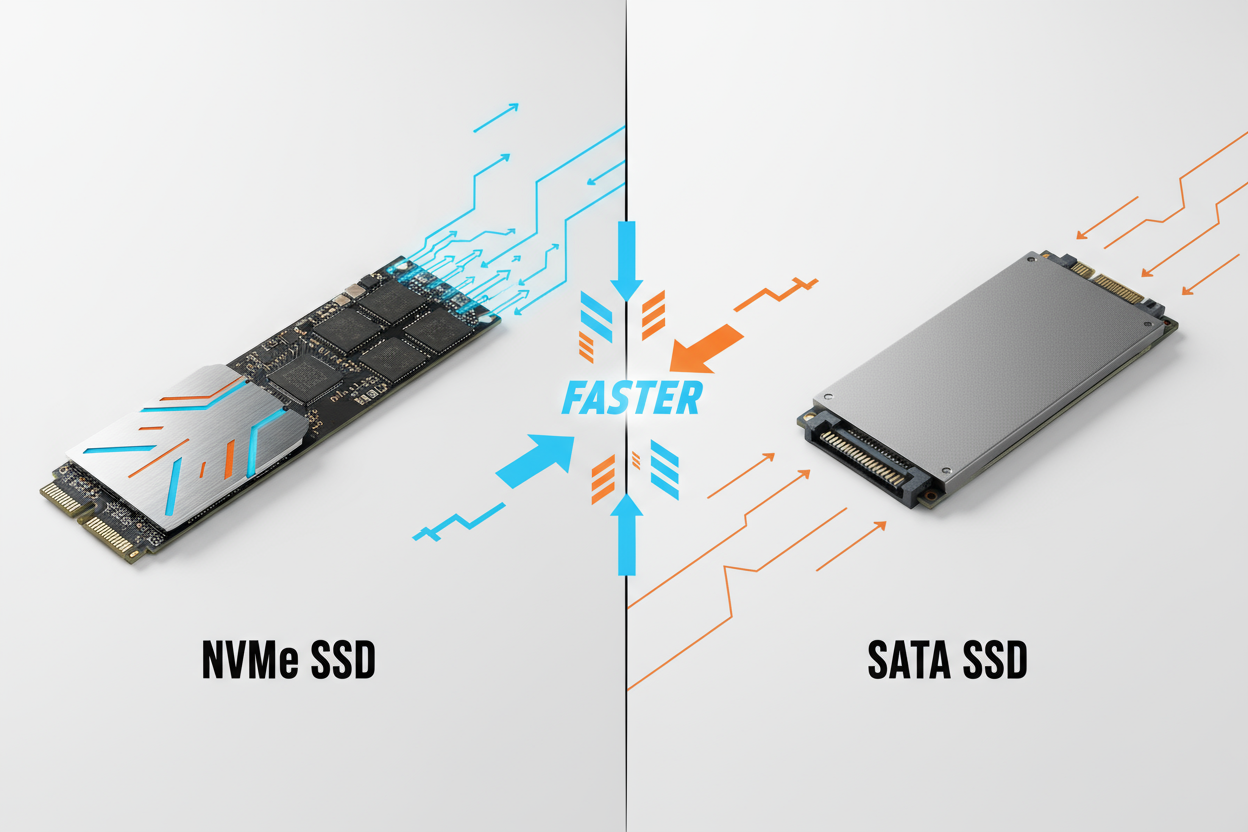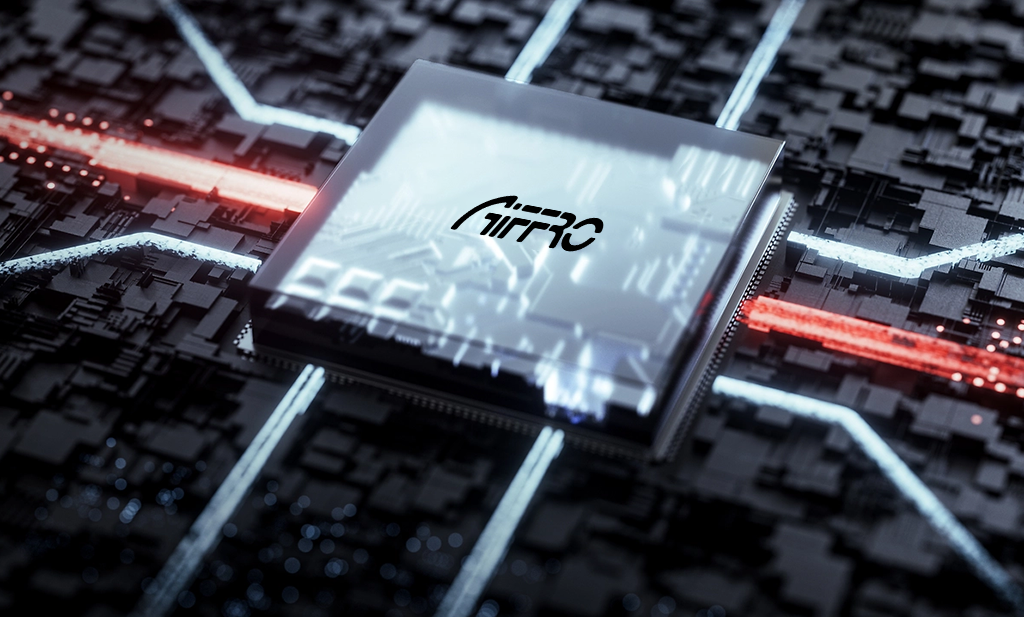There was a time of bulky hard drives, and then the world saw SSDs. If you’ve built a PC in the past or upgraded your laptop, chances are you’ve heard about NVMe SSD and SATA SSD. Both are solid-state drives and work far better than mechanical hard drives.
But when we come to think about NVMe vs SATA SSD, we see a clear difference in the resultant speed and future proofing. Let’s Aiffro help you make a comprehensive comparison of NVME SSD vs SATA SSD and NVME vs SSD.
We’ll explain how they differ, and show you why NVMe SSDs are the smarter choice for most people. We’ll also share some real-world device examples of how NVMe drives can be used for fast and reliable storage.
What is an SSD and Why It Replaced HDDs
We have to first look at SSDs in general before understanding the difference between NVMe and SATA. SSD is a Solid State Drive that stores data on a NAND flash memory chip.
SSDs are different from hard disk drives that rely on spinning platters and a moving read/write head because they have no moving parts. These features make them:
- More reliable and shock-resistant.
- More efficient in reading and writing data.
- Less noisy and cooler.
- More durable.
- Power saver.
These benefits make SSDs a better primary storage option than HDDs in most modern laptops and desktops. But even within SSDs, we have to connect the interface with the computer, which makes a big difference in performance. That’s the point, we are introduced to SATA SSD and NVMe SSD, the portable SSDs.
SATA SSD: The Traditional Option
SATA SSDs were the first type of SSDs to become prominent. They connect through the same SATA III interface that was originally made for hard drives. This feature makes them highly compatible but also limits their performance. Prominent features are:
Maximum Speed:
Its maximum speed is around 500–550 MB/s for sequential reads and writes.
Form Factor:
Usually, these drives are 2.5 inches in size. But some newer devices use M.2 drives, which are smaller and more compact.
|
Pros |
Cons |
|
Affordable |
Much slower than NVMe |
|
Work with older systems |
Limited by the old SATA standard |
|
Reliable |
A SATA SSD feels like a huge jump in speed for those who are upgrading from an HDD. But the gap becomes obvious when we compare it with NVMe.
NVMe SSD: Built for Speed
Non-Volatile Memory Express or NVMe, is a newer storage protocol, specifically made for SSDs. It uses PCI Express (PCIe) lanes instead of using the older SATA connection.
It gives the drive direct communication with the CPU. This setup removes the obstructions of the previous devices and allows much higher speeds:
Typical Speeds:
It offer 2000 MB/s to 3500 MB/s speed on PCIe 3.0 drives. The PCIe 4.0 models reach 7000 MB/s, and PCIe 5.0 promises even more.
Latency:
The previous one offers a low response time during opening apps, loading files or multitasking. The NVMe SSD makes this response quick and efficient.
Form Factor:
Most NVMe SSDs use the M.2 slot on motherboards. But we also have external versions available in portable enclosures.
NVMe SSD provides a noticeable boost in speed and responsiveness for gaming, video editing or working with large data type heavy workloads.
NVMe vs SATA SSD Main Differences
Here is the comparison of NVMe vs SATA SSD to understand their features better.
|
Feature |
SATA SSD |
NVMe SSD |
|
Interface |
SATA III (6 Gbps) |
PCIe (x4, x8) using NVMe protocol |
|
Max Speed |
~550 MB/s |
2000–7000+ MB/s |
|
Latency |
Higher |
Lower |
|
Form Factor |
2.5-inch or M.2 |
Mostly M.2, U.2, or portable NVMe |
|
Price |
Cheaper |
Slightly more expensive |
The numbers speak for themselves: NVMe SSDs are five to ten times faster than SATA SSDs in raw speed.
Real-World Performance
Benchmarks suggest that NVMe SSDs are significantly faster than SATA SSDs, but let’s do a practical comparison to check the actual performance:
Boot Times
- A system with an NVMe SSD boot time is slightly better than a SATA SSD, which is quick but not as snappy as the other.
App and Game Loading
- Systems with NVMe SSDs drastically reduce load times in modern games and speed up Photoshop or Premiere Pro types of large applications.
File Transfers
- NVMe SSD is good for file transfer as it moves a 50 GB video project in seconds. While SATA SSDs do this project in minutes.
Video Editing:
- NVMe SSDs have higher read speeds, which make scrubbing through 4 K and 8 K footage smoother than SATA SSDs. SATA SSDs have lower read speed, which causes lags, delays or stuttering while scrubbing through heavy files.
Multitasking:
- NVMe is a multitasker as it handles multiple operations at once without slowing down.
This real-time comparison shows that NVMe SSD isn’t just about fast numbers but also shows results in practical use.
NVMe SSD vs SATA SSD: Which One Should You Choose?
We have discussed NVMe vs SSD and NVMe vs SATA SSD, but choosing a product depends on your needs and budget.
- SATA SSD is fine only for casual users who just browse, stream and store photos.
- Gamers and creative professionals get a lot of benefits from an NVMe SSD.
- People who have older devices that will not support NVMe slots. They only have the SATA choice.
NVMe prices are dropping steadily. The cost difference doesn’t matter in front of its benefits. That’s why tech experts always find NVMe to be a smarter choice and a long-term investment.
Future-Proofing Your System with NVMe SSD
Storage space becomes a problem as software and media get heavier. Speed matters more as high-resolution video, massive games, and AI-driven workloads demand faster performance.
NVMe SSD can be the best choice as it ensures your system won’t feel outdated soon. SATA SSDs remain popular among users with older systems and limited budgets. But the shift towards NVMe is clear. Many new laptops no longer include SATA.
Things to Look for When Buying an SSD
Some points you need to consider for avoiding confusion when comparing NVMe vs SSD or NVMe vs SATA SSD options:
- Check compatibility by finding out if your motherboard or laptop supports NVMe M.2 slots.
- What’s your system form factor? Desktop users often have space for M.2 NVMe, but laptops may be limited.
- NVMe SSDs can get hot; look for heat sinks or external cooling in heavy use.
- Get an understanding of capacity vs budget because bigger drives are faster but more expensive.
- Choose NVMe for speed-heavy work, SATA if you only need simple storage.
Conclusion
NVMe SSD and SATA SSD are far better than old hard drives, but when you put them head-to-head, NVMe clearly comes out on top. It’s faster and more efficient, which makes it better suited for modern workloads.
A SATA SSD is fine for light users on a tight budget. But if you want speed, reliability and future-proof performance, NVMe SSD is the way forward.
The best decision is if your system supports NVMe, go for it. You’ll feel the difference every single day.





Hinterlasse einen Kommentar
Diese Website ist durch hCaptcha geschützt und es gelten die allgemeinen Geschäftsbedingungen und Datenschutzbestimmungen von hCaptcha.